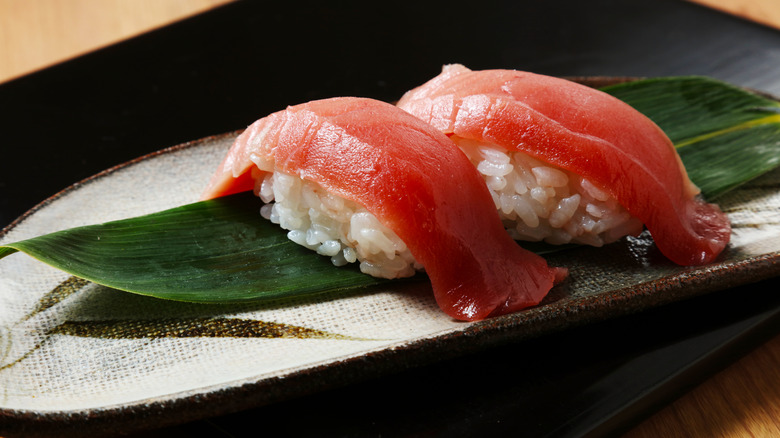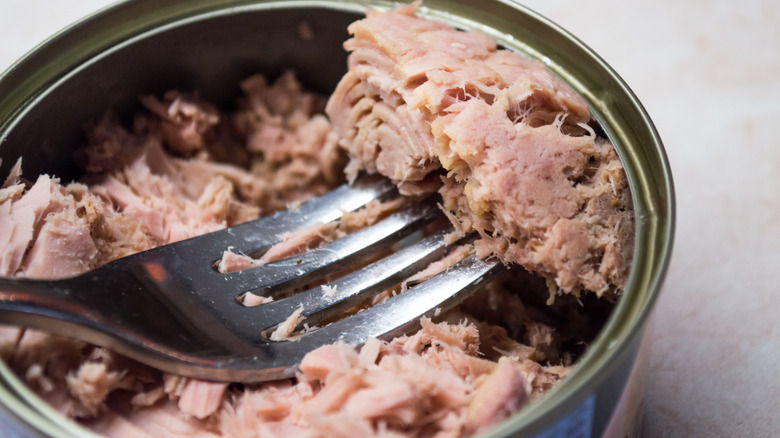The Tuna Varieties With The Highest And Lowest Mercury Levels
Tuna is a lean, nutrient-rich protein that packs in a lot of health benefits, like omega-3 fatty acids. These unsaturated fatty acids, which are plentiful in tuna, may improve your heart health by lowering your blood pressure and reducing inflammation and triglycerides — a type of fat — in your blood, among other benefits. The USDA recommends that adults eat 8 ounces of seafood per week as a part of a healthy diet, so choose wisely. Tuna is known to contain mercury, a neurotoxin that can negatively impact your health, causing problems including muscle weakness, per the U.S. Environmental Protection Agency.
While mercury is naturally occurring, mercury from coal-fired power plant emissions and other industrial sources also gets into the marine food chain. When bigger fish eat smaller fish, mercury accumulates in their bodies. The larger the fish, the more mercury they may have. This plays into which tuna has the highest levels of mercury and the lowest. The U.S. Food and Drug Administration found that of all the tuna species it tested, fresh or frozen bigeye tuna has the highest level of mercury. Canned light tuna, which is typically skipjack, has the lowest. This might sound scary, but don't worry: You're not that likely to get mercury poisoning from canned tuna. (And many types of non-canned tuna are safe for most people too, as long as you're staying aware of serving size and moderation.) Non-pregnant adults can safely eat two to three 4-ounce servings (the amount found in a typical can) of light canned tuna per week, per the FDA. For canned albacore, one 4-ounce serving a week is the recommended limit.
Big fish, little fish, and mercury
Once we dive into the different types of tuna out there, you'll see why bigeye tuna contains more mercury than most other tuna species. Bigeye tuna develop more slowly and grow to be around 5 ½ feet long. This combination of factors leads to this type of fish having more mercury in its body when it ends up on your plate. Interestingly, the FDA doesn't include bluefin tuna anywhere in its ranking of mercury content in commercial fish. But as the largest tuna species — it can grow to more than 13 feet — bluefin, which is often used in sushi, contains higher amounts of mercury than smaller species like yellowfin, a 2010 American Museum of Natural History and Rutgers University study found.
Canned light tuna has the lowest level of mercury as far as tuna goes, and skipjack is the most common fish used in this product. Skipjack is the smallest tuna species, averaging 3 feet in length. Canned albacore — another larger species of tuna — has a higher level of mercury compared to most canned tuna, around three times the amount found in canned skipjack and other light tuna on average. (But remember, most people can safely eat canned albacore in moderation.)
Canned tuna over fresh tuna?
Surprisingly, even when you compare fresh albacore and skipjack with the canned versions of these fish, the canned option contains less mercury on average. That may be due to the fishing industry catching younger fish for canning over those that end up at fish counters as filets. Younger fish haven't had time to accumulate as much mercury in their bodies as older fish. It should be noted that the FDA does not include canned yellowfin on its standard list. It does include fresh or frozen yellowfin tuna, on the other hand, which has a higher level of mercury than even canned albacore but still falls below fresh or frozen bigeye tuna for mercury levels.
Now that you know canned light tuna has the lowest amount of mercury, try following kitchen icon Julia Child's ideas for elevating tuna salad sandwiches by adding lemon juice, capers, and cornichons for a brighter and crunchier meal. Seafood, including tuna, should be on your weekly menu rotation — and now you know how to safely incorporate it into your diet.


